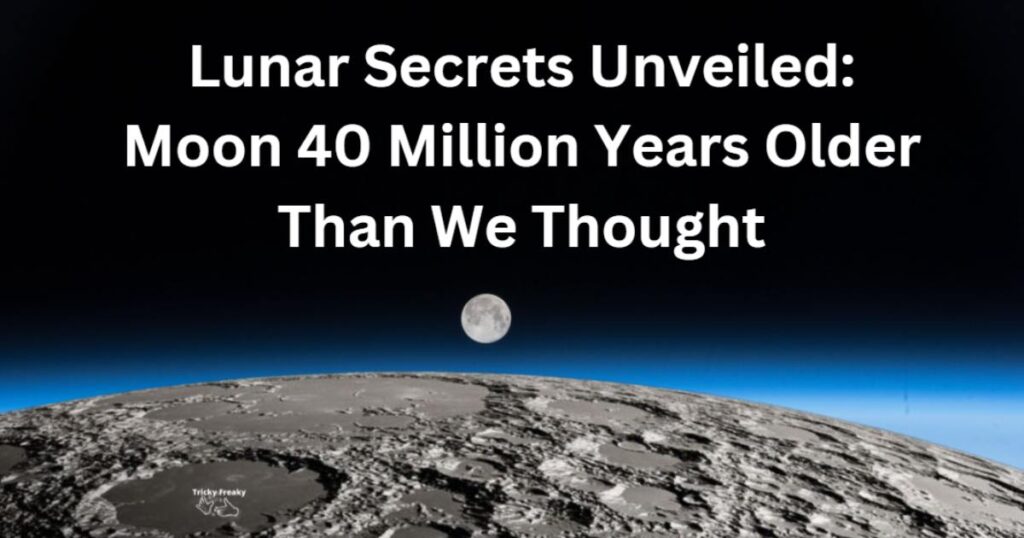The moon, Earth’s constant companion and the subject of countless myths, poems, and scientific inquiries throughout history, has once again captured our fascination. Recent revelations stemming from a decades-old space mission have unveiled a moon older than we ever imagined. It turns out that our lunar neighbor is 40 million years older than previously believed, pushing its age back to a staggering 4.46 billion years. How was this discovery made, and what does it mean for our understanding of our celestial neighbor?
In 1972, Apollo 17 astronauts embarked on a historic mission to the moon. They returned to Earth bearing a precious cargo – lunar dust containing tiny crystals that would go on to hold secrets locked away for over half a century. These minuscule crystals, once trapped in lunar soil, have now become the key to unlocking a significant chapter in lunar history.

This breakthrough revelation comes from a meticulous study that involved a cutting-edge technique known as atom probe tomography. Through a detailed, atom-by-atom analysis of these crystals, scientists have pieced together an astonishing narrative that reshapes our perception of the moon’s origin and age.
The Age of the Moon: A 40 Million-Year Time Warp
Until now, the generally accepted age of the moon was believed to be around 4.42 billion years. This estimate was based on previous research and understanding of the moon’s formation. However, the recent findings, made possible by the high precision of atom probe tomography, have thrown a cosmic curveball. It’s now clear that the moon predates our previous estimates by approximately 40 million years.
This revelation is more than just a number; it’s a leap back in time to the early days of our solar system. Our lunar companion, which has witnessed eons of Earth’s history, was formed earlier than we had ever imagined. Such a revision in age raises intriguing questions about the moon’s role in the development of our solar system and our planet.
Crystals: Guardians of Ancient Lunar History
At the heart of this discovery are the minuscule crystals that lay dormant within lunar dust. These crystals, now aged at 4.46 billion years, represent the oldest known solids formed after the colossal impact that gave birth to the moon. The moon’s origins have long been linked to a dramatic event – the collision of a Mars-sized object with Earth. The moon emerged from the debris of this cataclysmic collision, but the exact timing of this event remained shrouded in mystery until now.
According to Philipp Heck, a specialist in cosmochemistry and planetary sciences at the Field Museum and a professor at the University of Chicago, “These crystals are the oldest known solids that formed after the giant impact.” In essence, they are the guardians of lunar history, preserving secrets from the momentous birth of our moon.
A Cooling Lunar World
The study’s findings also illuminate a crucial aspect of the moon’s formation. The collision that gave rise to the moon would have unleashed an unimaginable amount of heat, melting the rock that would eventually become the moon’s surface. However, as Heck explains, “When the surface was molten, (these) crystals couldn’t form and survive. Any crystals on the moon’s surface must have formed after this lunar magma ocean cooled.”
In essence, these crystals could only have formed after the moon’s surface began to cool. They provide a unique window into the cooling process of the lunar world, shedding light on how this desolate landscape took shape and gradually solidified.
Radioactive Decay: A Cosmic Clock
One of the most fascinating aspects of the analysis is the evidence of radioactive decay within the crystals. Radioactive decay is a natural process in which atoms transform over time. The presence of such decay within these lunar crystals serves as a cosmic clock, ticking away the eons and confirming their ancient origins.
The knowledge that these crystals have borne witness to the slow but steady march of time for billions of years adds to their allure. They stand as remarkable witnesses to the turbulent birth of the moon and its subsequent evolution.
Revealing Our Cosmic History
So, what does this newfound knowledge mean for our understanding of the moon and the solar system’s history? Firstly, it redefines the moon as a witness to the dawn of the solar system. It is a celestial body older than many of the celestial wonders it shares the cosmos with. The moon, with its new birthdate, carries tales of the early universe within its silent craters and ancient landscapes.
Beyond its individual significance, the moon also helps unravel the larger narrative of our solar system’s formation. Every celestial body carries its own story, and by understanding the moon’s story better, we can piece together the jigsaw puzzle of the solar system’s early days.
This revelation also underscores the crucial role of scientific curiosity and advanced technology in pushing the boundaries of human knowledge. The discovery is a testament to the relentless quest for understanding our universe, a journey that began with humble Earthbound observers and has now taken us to the moon’s surface and back.
In essence, the moon’s age revelation is more than a mere scientific adjustment; it’s a humbling reminder of how little we know about the cosmos and how much there is left to explore. It encourages us to look up at the night sky with fresh wonder and to recognize that the celestial bodies we see have stories to tell, stories that may challenge our preconceptions and expand our horizons.
As we continue to study these lunar crystals and uncover the moon’s secrets, we move one step closer to understanding our place in the cosmos. With every discovery, we add another layer to the intricate tapestry of the universe, enriching our human story with the ancient tales of celestial companions like the moon.
So, the next time you gaze up at the night sky and see the silvery orb of the moon, remember that it has seen the birth of stars and galaxies, the formation of our solar system, and the evolution of life on Earth. It’s a reminder that the universe is a vast, mysterious, and ever-evolving place, and that our journey to explore and understand it has only just begun.
